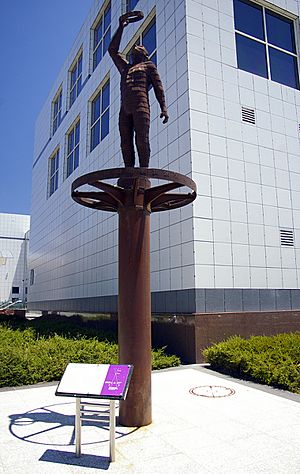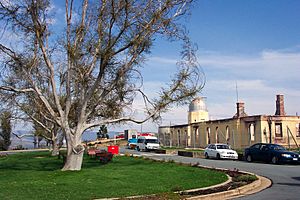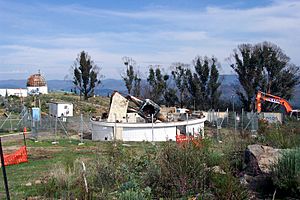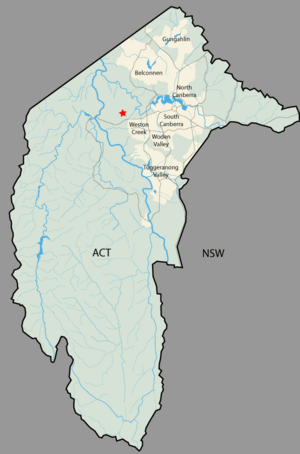Mount Stromlo Observatory facts for kids

The Mount Stromlo Observatory (MSO) is a famous place for studying space. It's located just outside Canberra, Australia. This observatory is part of the Research School of Astronomy and Astrophysics at the Australian National University (ANU). Scientists here use powerful telescopes to learn about stars, galaxies, and the universe.
Contents
History of Mount Stromlo
The observatory first opened in 1924. It was called The Commonwealth Solar Observatory back then. But even before that, people were using Mount Stromlo for observations. A small observatory was built there in 1911. It housed the Oddie telescope. The building for this telescope was the very first Commonwealth building in the new Australian Capital Territory.
Before World War II, the observatory mostly studied the Sun and Earth's atmosphere. During the war, its workshops helped by making gun sights and other optical gear. After the war, the observatory started looking at stars and galaxies. It was then renamed The Commonwealth Observatory.
The ANU started in Canberra in 1946. The university and the observatory began to share staff and offer advanced studies. In 1957, Mount Stromlo Observatory officially became part of the ANU.
The 2003 Bushfire
On January 18, 2003, a huge bushfire swept through Canberra. It hit Mount Stromlo very hard. The observatory was surrounded by a forest of pine trees. Five telescopes, many workshops, seven homes, and the old administration building were all destroyed.
Only one telescope survived the fires. This was the 1868 15-centimetre Farnham telescope. Some items damaged by the fire are now on display. You can see them at the National Museum of Australia. These include a melted telescope mirror and a piece of melted glass. This glass even has bits of charcoal and wire stuck in it from the intense heat.
Most of the observatory has now been rebuilt. Mount Stromlo is a key partner in building the huge Giant Magellan Telescope. A copy of the original Oddie telescope is also on display at the observatory.
Amazing Discoveries and Research
Scientists at Mount Stromlo have made many important discoveries. They use special cameras and telescopes to explore space.
The MACHO Project
In 1993, the MACHO project found the first example of something called Gravitational microlensing. This happens when one star's gravity bends the light from another star. It makes the background star appear brighter for a short time.
This discovery was made by taking many pictures of the Magellanic Clouds. They used the 50-inch Great Melbourne Telescope. This telescope had a special camera made of eight CCDs. At the time, it was the largest digital camera ever built! The MACHO project took over 200 billion measurements of stars.
Discovering Dark Energy
Brian Schmidt, a scientist at Mount Stromlo, led a team that studied how fast the universe is expanding. They looked at special exploding stars called Type Ia supernovae. In 1998, they made a surprising discovery. They found that the universe's expansion is actually speeding up, or accelerating! This was the opposite of what scientists expected.
This universal acceleration means that something called dark energy must exist. Dark energy is a mysterious force that pushes galaxies apart. This discovery was named the top science breakthrough of 1998. In 2011, Brian Schmidt shared the Nobel Prize in Physics for this amazing finding. He shared it with Saul Perlmutter and Adam Riess.
Mapping Galaxies
The 2dF Galaxy Redshift Survey was another huge project. It was co-led by Matthew Colless. This survey measured the "red shift" of more than 245,000 galaxies. Redshift tells scientists how far away galaxies are and how fast they are moving away from us. This project helped create the largest map of galaxies at that time. It gave us a better understanding of the universe's large-scale structure.
Building Advanced Instruments
The workshops at Mount Stromlo Observatory are very skilled. They have built special instruments for the Gemini Telescope. These include NIFS and GSAOI. NIFS is a special camera used to study objects in infrared light. GSAOI helps make images clearer by correcting for distortions from Earth's atmosphere.
Sadly, the original NIFS was destroyed in the 2003 bushfires. But the team rebuilt it!
A new telescope called SkyMapper is also being built. SkyMapper will be located at ANU's other observatory, Siding Spring. However, it will be controlled remotely from Mount Stromlo. SkyMapper will quickly survey the sky, looking for new objects and events.
Location
Mount Stromlo Observatory sits on Mount Stromlo. It is about 770 metres (2,530 ft) above sea level.
|
See also
 In Spanish: Observatorio del Monte Stromlo para niños
In Spanish: Observatorio del Monte Stromlo para niños




